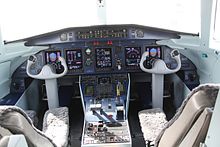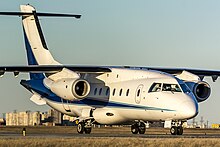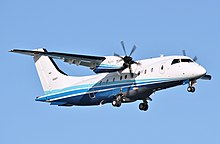Dornier 328
| Dornier 328 | |
|---|---|
 A Dornier 328-100 |
|
| Type: | Short Track - airliner |
| Design country: | |
| Manufacturer: |
|
| First flight: |
December 6, 1991 |
| Commissioning: |
1993 |
| Production time: |
|
| Number of pieces: |
217 pieces and 3 prototypes |
The Dornier 328 is a depending on the version of Jet - or turboprop equipped -drive passenger aircraft for short-range , equipped with a pressurized cabin . It is the last aircraft type to be flown that was planned and designed by the original Dornier factories . It was then built and sold by Dornier Luftfahrt GmbH as a subsidiary of the Daimler subsidiary DASA at the time . It is also the last commercial aircraft to be developed and built entirely in-house by a German company.
history
The development of the 328 goes back to the 1980s. It should complement the Dornier 228 . At that time, Dornier came to the conclusion through market research that there was a market niche in the segment of small regional aircraft for up to 33 passengers. The machine was designed very promisingly on the basis of a new circular fuselage with a cabin width of 2.18 m, combined with the existing and fully developed wings of the Do 228 TNT . As a result, in December 1988, work began on developing a new aircraft, the Dornier 328-100. The first flight took place three years later on December 6, 1991, certification followed in October 1993.
During development, special emphasis was placed on high speed and a high rate of climb, which was achieved through the use of the new technology wing (TNT) and completely newly developed propellers. Furthermore, the stern was built with a tail unit made of composite material . A “ glass cockpit ” with five screens from Honeywell Primus Avionics, which was still unusual in aircraft of this size at the time, was also integrated instead of the analogue pointer instruments that were common at the time. Head-up displays were even available as options. This equipment made the development so expensive that it was already foreseeable on the first flight that the Dornier 328 program would only pay off after 300 aircraft were sold, but this was accepted. A total of 217 aircraft (plus three prototypes for certification / approval tests) of all variants on the most modern production facilities of the German aviation industry at the beginning of this century were built in Oberpfaffenhofen by 2005 (in addition to a "straggler" [SN 221] completed in 2008) from the bankruptcy estate since the first delivery in 1993, 107 turboprop versions of the Dornier 328-100 type and a further 110 jet versions of the Dornier 328-300 type. As part of the adjustments (see: End of the Cold War ), the military-oriented DASA decided to hand over regional aircraft construction to Fairchild , a company with experience in the civilian market . After the sale of Dornier Luftfahrt GmbH in 1996, an additional version, the 328JET, was launched in February 1997. The Fairchild Dornier company was on healthy feet, as DASA / Daimler-Benz had taken over the accumulated development costs in a special write-off when it was sold.
However, turboprop aircraft were unpopular during the 1990s . During this time, airlines preferred small jets such as the Bombardier Canadair Regional Jet , whose lower efficiency was accepted because of the clear image difference between the “new” jets and the “outdated” propeller technology. Fairchild Dornier countered this trend with the development of the 328JET, a jet-powered version of the Dornier 328. When a post-crisis recovery later emerged, the trend towards larger aircraft was foreseeable, so Fairchild Dornier designed the extended versions 428 and 528 and then the more promising Dornier 728 began. When Lufthansa canceled an option for 60 728 models as a result of the terrorist attacks on September 11, 2001 , the end of the year came for the company and, despite the purchase by Avcraft, later also for the 328. However, support and spare parts production is still provided by 328 Support Services on former Dornier site in Oberpfaffenhofen, which has taken over the type certificate and thus the responsibility for prototyping for customers all over the world for the Do-328 series.
The first Dornier Do 328 with a propeller turbine was delivered to the Swiss airline Air Engiadina in 1993. The second prototype was converted into a technology demonstrator for a new cargo aircraft by Lockheed Martin for the research department of the US Air Force (AFRL - Air Force Research Laboratory) as an Advanced Composite Cargo Aircraft (ACCA), for which the fuselage was replaced by a 16.8 m long and 3.05 m wide plastic cell was replaced. The machine was named Lockheed Martin X-55 .
In May 2015, plans to resume production of a modernized Dornier 328JET as the TRJ-328 in Ankara under the leadership of STM Defense Technologies were announced. In addition, an enlarged version TRJ-628 should be developed by 2023. In June 2018, plans were also announced to resume production by 328 Support Services GmbH , which had taken over worldwide customer service and type certification after production was discontinued. The company is a subsidiary of the British Sierra Nevada UK Ltd, which is part of the US Sierra Nevada Corporation . In 2018, the search for a possible location was limited to Bremen and Leipzig / Halle Airport . The decision for the Leipzig / Halle location was announced in summer 2019.
particularities
The aircraft stood out from its competitors due to some new technologies and design features. Even a statement from the Daimler-Benz headquarters in Stuttgart, was following as the then owner of the Dornier works, invested within the meaning of Mercedes-Image heavily in design and equipment and the latest production equipment, reaching the break-even point , however, also slid. The cross-section of the fuselage, the newly developed propeller and active electronic noise damping by means of anti- noise provided jet-like cabin comfort. A higher speed on arrival and departure ensured that the aircraft could be included in the normal approach management of the large commercial airports. Therefore, this machine was bought by the airlines as a feeder and is still used today.
Versions
Dornier 328-100

The standard version of the Dornier 328 is available in several versions with the same cabin for a maximum of 33 passengers. In addition to the original 328-100, a 328-110 with increased take-off weight and greater range, the 328-120 with special equipment for short-haul flights and the 328-130 with improved rudder and higher speed were offered.
Since the first delivery in 1993, the Dornier 328-100 has been sold a total of 107 times until production of the turboprop variant in Oberpfaffenhofen was discontinued in 1999 in favor of the jet variant. 104 of this turboprop version are currently still in use.
All basic versions of the 328-100 manufactured up to 1993 were later modified to the 328-110 standard with more powerful engines in order to enable further increases in performance and shortening of take-off distances with PW119C propeller turbines as versions 328-120 and -130.
Dornier 328-300 / 310JET

The Dornier 328-300 or Dornier 328JET founded a new segment of extremely small jet-powered regional aircraft in 1997. The first prototype - a converted Dornier 328-100 - completed its rollout on December 6, 1997 in Oberpfaffenhofen near Munich and made its maiden flight there on January 20, 1998. The type certification and the first delivery followed in mid-1999. By 2008 a total of 110 copies of the 328-300 jet version had been delivered. A first copy completed after the dissolution of Fairchild-Dornier by the company 328 Support Services went to the Austrian company "Easy Aviation" in August 2008. This Dornier Do 328 jet from Easy Aviation - with the aircraft registration number of the Cayman Islands VP-CJD - is the private jet of the former Formula 1 racing driver Gerhard Berger .
This - as serial number 221 (of 224 pieces / all versions / in total) - was thus the last commercial aircraft developed and built completely in Germany and - as yet unfinished - belonged to the bankruptcy estate of Fairchild-Dornier. It was only completed, but not completely re-produced. A variant as Do 328 MPA (Maritime Patrol Aircraft) of the turboprop version was also completely developed in response to requests from Italy, Scandinavia and the UAE and with "Belly Radar / Radom" between the landing gear covers in the United States - based on the successful Do 228 MPA - offered for coastal surveillance, but not built.
The main difference from the 328 to 100 is found in the PW306B- turbofans of Pratt & Whitney . Otherwise, only minimal changes were made in order to keep production costs low and not endanger commonality.
Of the Dornier 328-300 / 310 version equipped with jet engines, 110 pieces were manufactured and sold in the modern production halls in Oberpfaffenhofen, all of which have so far been spared fatal accidents. However, there have been a few cases of the end of the runway rolling over, as is the case with the turboprop variant as a result of failed take-offs, with a subsequent technical total write-off or an economic total write-off .
Dornier 428JET
Under Fairchild Dornier, a 44-seat version of the 328Jet called the 428Jet had been developed, which was to be built together with Israel Aircraft Industries . However, the project was discontinued in summer 2000, although some firm orders had already been placed. The termination of the project caused financial depreciation and additional costs of 300 million euros for Fairchild-Dornier. Avcraft wanted to take up this concept again, but ultimately failed due to the lack of financing options and the low sales potential in the market that was already saturated with the Bombardier CRJ100 and the Embraer ERJ 145 .
Dornier Envoy 3
A successful business jet version of the Dornier 328-300 was offered under the name Dornier Envoy 3 , which had an extended range.
operator
Civil use
As of July 2015, 134 of the 217 copies produced are still in active service. The largest operators include Sun Air of Scandinavia and MHS Aviation in Munich. Eight machines were scrapped, many more are mainly parked in China.
Military use
Since 2013, the US operates Air Force Special Operations Command (AFSOC) several upgraded copies, which the United States Air Force as a C-146A respectively. In early 2017, the 20th modified machine was delivered to the US military.
The used machines come from various users around the world and were converted into various configurations for their military tasks at the Oberpfaffenhofen site. These include spoilers for short take-offs and landings, APU , gravel protection and new avionics.
The AFSOC uses them for the transport of personnel and material, they are operated by the 27th Special Operations Wing at Cannon Air Force Base in New Mexico .
Technical specifications
| Parameter | Dornier 328-100 | Dornier 328-300JET | Dornier 328-310JET | Dornier 428JET |
|---|---|---|---|---|
| Passengers | 30-33; Luxury / business equipment "Envoy 3": 10–12 | 44 | ||
| length | 21.23 m | 24.69 m | ||
| span | 20.98 m | 21.78 m | ||
| height | 7.05 m | 7.09 m | ||
| Wing area | 40 m² | 47.8 m² | ||
| Wing extension | 11.0 | 9.9 | ||
| Max. payload | 3,450 kg | 3,410 kg | 3,266 kg | 4,855 kg |
| Max. Takeoff mass | 13,990 kg | 15,200 kg | 15,660 kg | 19,800 kg |
| Engines | two Pratt & Whitney PW119B turboprop engines with 1,400 kW each (or PW119C for high and hot conditions) |
two Pratt & Whitney PW306B turbofan engines with 26.9 kN thrust each | two Pratt & Whitney PW308B turbofan engines with 32.9 kN thrust each | |
| Max. Cruising speed | 620 km / h | 740 km / h | ||
| Service ceiling | 7,620 m | 9,449 m | ||
| Range | 1,310 km with 32 passengers | 1,710 km with 32 pass. | 1,980 km with 32 pass. | 1,665 km |
Incidents
Between the commissioning of the Dornier 328 until March 2020, only one fatal accident occurred; four people were killed:
- A Dornier 328-110 (D-CPRR) had an accident on February 25, 1999 . The Minerva Airlines machine , which was operated for Alitalia , shot over the end of the runway when landing in Genoa , among other things because it was landed with an impermissibly strong tailwind and touched down much too late. Four people were killed (see also Alitalia flight 1553 ) .
See also
literature
- Rainer W. During: Comeback for the Do 328. In: FliegerRevue , No. 10/2019, pp. 24-25
- Uwe W. Jack: Fresh wind for Dornier Do 328. In: FliegerRevue No. 9/2017, p. 34
Web links
- Website of 328 Support Services GmbH (current owner of the rights of the type)
- Type certification of the Dornier 328 - EASA-TCDS-A.096, Edition 7, July 01, 2019 (PDF; 750 kB)
- TRJet-Turkish regional aircraft project official page
- Dornier 328 JET Publication Index
- Dornier 328 - aircraft pictures and seating plan
- Civil aviation: Dornier Do 328
- Photos of the Dornier Do 328
- Dornier Do-328 Production List on planespotters.net
- Photos of the Easy Aviation aircraft
Individual evidence
- ↑ FliegerRevue, September 2009, pp. 22-23, The Do328 is to become the X-55
- ↑ TRJ-328: How 'Turkish' is the Turkish aircraft project?
- ↑ https://328.eu/company/quest-aviation-services-limited/
- ↑ Steffen Höhne: New production planned: Will this iconic airplane be built in Leipzig soon? In: Mitteldeutsche Zeitung . ( mz-web.de [accessed on June 14, 2018]).
- ↑ Timo Nowack: The new Dornier 328 is built in Leipzig. In: aeroTELEGRAPH. August 14, 2019, accessed August 15, 2019 .
- ↑ J. Flottau: The Fairchild-Dornier-Story (Part 1). In: Aero international 8, 2003, p. 26.
- ↑ a b ch-aviation.ch - Aircraft (English) accessed on April 17, 2012.
- ↑ a b 328 Support Services GmbH hands over 20th Dornier 328 Turboprop to US Military. (English) accessed on February 1, 2017.
- ↑ Dornier 328-100TP. 328 Support Services GmbH, August 2013, accessed on July 25, 2014 (English).
- ↑ Dornier 328-300 (Light Jet). 328 Support Services GmbH, August 2013, accessed on July 25, 2014 (English).
- ↑ Dornier 328-300 (Heavy Jet). 328 Support Services GmbH, August 2013, accessed on July 25, 2014 (English).
- ^ Accident report Dornier 328 D-CPRR , Aviation Safety Network (English), accessed on March 12, 2020.




